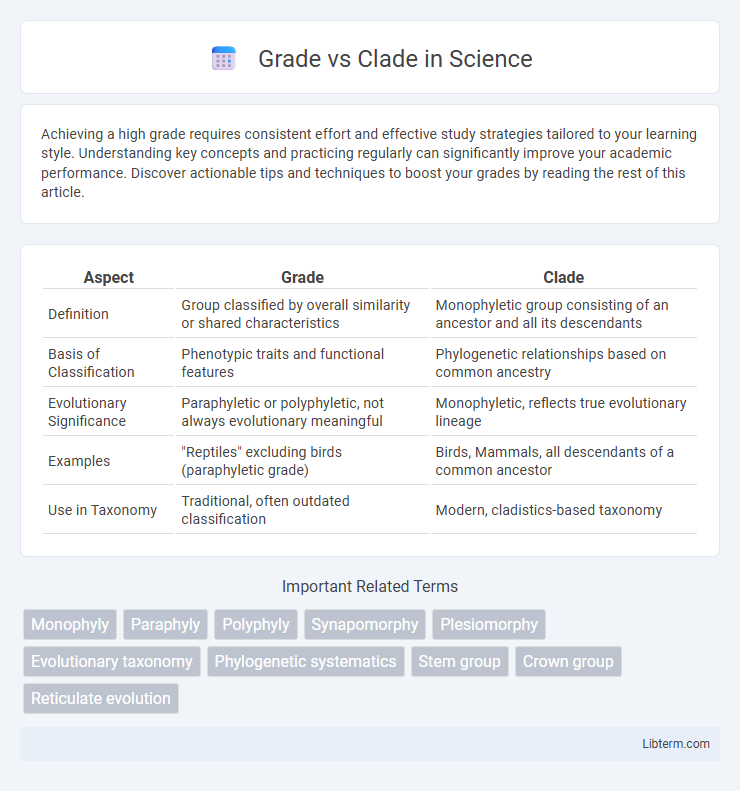Achieving a high grade requires consistent effort and effective study strategies tailored to your learning style. Understanding key concepts and practicing regularly can significantly improve your academic performance. Discover actionable tips and techniques to boost your grades by reading the rest of this article.
Table of Comparison
| Aspect | Grade | Clade |
|---|---|---|
| Definition | Group classified by overall similarity or shared characteristics | Monophyletic group consisting of an ancestor and all its descendants |
| Basis of Classification | Phenotypic traits and functional features | Phylogenetic relationships based on common ancestry |
| Evolutionary Significance | Paraphyletic or polyphyletic, not always evolutionary meaningful | Monophyletic, reflects true evolutionary lineage |
| Examples | "Reptiles" excluding birds (paraphyletic grade) | Birds, Mammals, all descendants of a common ancestor |
| Use in Taxonomy | Traditional, often outdated classification | Modern, cladistics-based taxonomy |
Defining Grade and Clade: Key Differences
A grade is a group of organisms classified together based on similar levels of organizational complexity or morphological traits, often representing a paraphyletic group that excludes some descendants. In contrast, a clade consists of an ancestor and all its descendants, forming a monophyletic group defined strictly by common evolutionary ancestry. The key difference lies in the grade grouping by shared characteristics regardless of lineage, whereas clades are determined by evolutionary relationships and genetic heritage.
Historical Development of Grade and Clade Concepts
The historical development of grade and clade concepts stems from early evolutionary biology's attempt to classify organisms based on shared characteristics and evolutionary relationships. Grades were initially used to group organisms by overall similarity and adaptive level, while the clade concept, emerging from phylogenetics, emphasizes monophyletic groups comprising an ancestor and all its descendants. Advances in molecular biology and cladistics have shifted taxonomy toward clade-based classifications, reflecting more accurate evolutionary histories than traditional grade groupings.
Phylogenetic Systematics: Why Clades Matter
Phylogenetic systematics prioritizes clades because they represent monophyletic groups containing an ancestor and all its descendants, reflecting true evolutionary relationships. Grades, defined by shared morphological traits without common ancestry, can mislead interpretations of evolutionary history. Emphasizing clades ensures classification aligns with genetic lineage and evolutionary divergence, enhancing accuracy in biological taxonomy.
Morphological Grades: Grouping by Similarity
Morphological grades categorize organisms based on shared physical characteristics rather than evolutionary ancestry, grouping species by similar morphological traits regardless of phylogenetic relationships. These grades often encompass multiple clades, reflecting convergent evolution or parallel adaptations to similar environments. While useful for descriptive purposes, morphological grades do not represent monophyletic lineages and can obscure true evolutionary histories revealed through genetic and cladistic analyses.
Monophyly vs Paraphyly: Clade vs Grade in Practice
A clade represents a monophyletic group consisting of an ancestor and all its descendants, reflecting true evolutionary relationships based on common ancestry. In contrast, a grade is paraphyletic, including organisms sharing similar traits but excluding some descendants, thus not representing a complete lineage. Practical taxonomy prefers clades for their accuracy in depicting evolutionary history, while grades are often used for convenience in classifying organisms with shared morphological features.
Famous Examples of Grades and Clades in Biology
Grades represent groups of organisms sharing similar levels of complexity or adaptive traits, such as reptiles defined by their ectothermic metabolism and scaled skin, whereas clades encompass organisms descended from a common ancestor, exemplified by the mammalian clade including monotremes, marsupials, and placental mammals. The traditional Grade-based grouping "Reptilia" excludes birds despite their evolutionary descent from theropod dinosaurs, which clade-based classification corrects by including birds within the clade Archosauria. Famous biological clades include the tetrapods, uniting all vertebrates with four limbs, and angiosperms, which comprise all flowering plants sharing a single common ancestor.
The Impact of Molecular Data on Classification
Molecular data has revolutionized the understanding of evolutionary relationships by enabling the classification of organisms based on genetic similarities rather than solely on morphological traits, distinguishing clades more accurately than traditional grade-based groupings. Clades represent monophyletic groups derived from a common ancestor, whereas grades often group organisms by shared physical characteristics without reflecting true evolutionary lineage. The incorporation of DNA sequencing and molecular phylogenetics has shifted taxonomy towards clade-based classifications, improving the accuracy of evolutionary trees and clarifying the natural history of species.
Grade vs Clade in Evolutionary Biology
Grade refers to a group of organisms sharing similar levels of morphological or physiological complexity, regardless of their evolutionary lineage, while clade denotes a monophyletic group consisting of an ancestor and all its descendants, representing a single branch on the tree of life. In evolutionary biology, clades provide a more accurate reflection of phylogenetic relationships based on common ancestry, whereas grades may group organisms by superficial similarities without reflecting true genetic kinship. The distinction between grade and clade is crucial for reconstructing evolutionary histories and understanding biodiversity through cladistic methodologies.
Implications for Taxonomy and Nomenclature
Grades represent groups classified by morphological or physiological traits without regard to evolutionary ancestry, whereas clades consist of organisms sharing a common ancestor, reflecting true phylogenetic relationships. The use of grades can lead to paraphyletic taxa that obscure evolutionary history, complicating taxonomy by grouping organisms based on superficial similarities. Cladistic classification enhances nomenclature by promoting monophyletic groups, ensuring taxa accurately reflect evolutionary lineages and facilitating clearer, more consistent scientific communication.
Future Directions: Integrating Grades and Clades
Integrating grades and clades offers a refined framework for understanding evolutionary relationships by combining morphological diversity with genetic lineage data. Advances in computational phylogenetics and genomic sequencing can facilitate the synthesis of traditional grade-based classifications with clade-based, monophyletic groupings to enhance taxonomic resolution. Future research emphasizes developing hybrid models that leverage both phenotypic traits and molecular evidence, improving predictive accuracy in evolutionary biology and biodiversity conservation.
Grade Infographic

 libterm.com
libterm.com